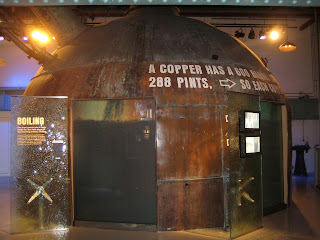
I thought it appropriate to dedicate this Saint Patrick's Day to learning more about this great beer. So I hopped a plane to Dublin.






The Birth of Guinness

Upon arrival in Ireland, I headed straight to Guinness's Saint James's Gate brewery, the house's original location. After an exhaustive inspection of the grounds (a.k.a. a self-guided tour) I learned the following:
In 1759 Arthur Guinness signed a 9,000-year lease for a brewery in Dublin called Saint James's Gate at the bargain prices of only 45 pounds' rent per year for a 4 acre property. (In later years the brewery expanded, but according to the Guinness company it would seem that the original lease agreement still applies to the original four acres. I'm not sure why they say "seem" since if anyone should know whether it does, they should.) The brewery was not in great shape when Arthur bought it, but he quickly got it up and brewing, and after only ten years he was even exporting beer to England. Then, in the 1770s Arthur tried his hand at a new style of beer emerging from England called a porter, a dark-colored beer that for the first time used roasted barley as an ingredient.
Stouts and porters
Lore has it that porter beers were named after the London street and river porters who popularized them. Traditionally, a brewery reserved the name "stout" (as in strong) for its strongest beers, those highest in alcohol. Hence, "stout porters" were originally those porters that were higher in alcohol. Guinness became famous for its stout porter, whose name in time was shortened to just plain "stout." Today, the terms "stout" and "porter" are sometimes (confusingly!) used interchangeably. Interestingly, most modern Guinness is weaker than it was in the 19th century, but the brewery does put out some versions that are higher in alcohol.
The brewery tour was full of information on how Guinness is made, including the ingredients used (barley, hops, water and yeast) ...

... and details of the brewing process.

... but I'd had enough theory for the time being. Off to the top floor bar for some practice.
The art of the pour


I then jetted back to the U.S. to celebrate Saint Patty's Day with my compatriots and share my new-found knowledge. I was greeted by the following posting at a local establishment:

No comments:
Post a Comment